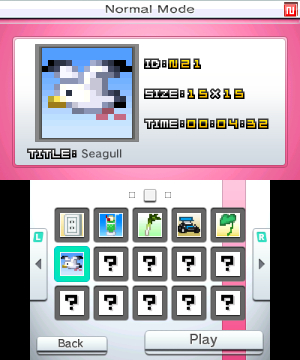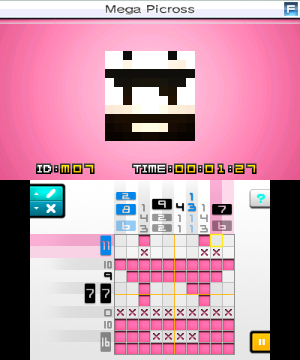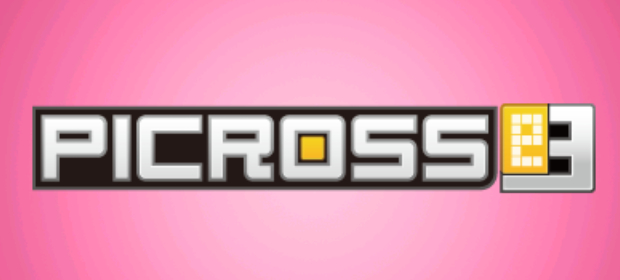The long-running Picross series has been a staple of Nintendo handheld systems for some time (although there were a few SNES versions, one of which made it’s way onto the Wii U Virtual Console earlier this year). Based upon an incredibly simple idea, the series’ approach to improvement is akin to the movement of the Earth’s tectonic plates – that is to say that over time there has been some change, but the differences have been so few that they’ve been barely visible.
 Clearly, Picross ain’t broke, so this latest version isn’t going to change the formula too much. For the uninitiated, Picross is a series of picture-based puzzles that start with a grid. Marking each row and column of the grid are a series of numbers, which communicate how many cells in the grid need to be filled in or left alone. The idea is to use these cryptic numerical instructions to fill in the correct cells and create a simple picture.
Clearly, Picross ain’t broke, so this latest version isn’t going to change the formula too much. For the uninitiated, Picross is a series of picture-based puzzles that start with a grid. Marking each row and column of the grid are a series of numbers, which communicate how many cells in the grid need to be filled in or left alone. The idea is to use these cryptic numerical instructions to fill in the correct cells and create a simple picture.
The idea is simple, but the same cannot always be said for the puzzles themselves. As a series, Picross prides itself on having a very smooth learning curve, with initial puzzles taking place on tiny grids with fewer number to fill in. Later on, those grids get bigger and the instructions get more and more complicated.
 e3 can be pretty much summed up as another set of Picross puzzles. The previous entry, e2, introduced the Micross mode, giving you 80×80 grids made up of smaller 10×10 puzzles. Sadly, this mode hasn’t carried over into e3, but in its place is a new Mega Picross mode. This is Picross at its most devious – the grids themselves are usual size, but some of the rows and columns have been combined. For example, you may have two rows joined together, with a giant 2 and a 5 next to them, which means you need to fill in an array of two cells, followed by an array of five cells. It’s a complicated mode that’s hard to explain but even more difficult to figure out. I consider myself a seasoned Picross veteran, but even I seriously struggled with the puzzles in this mode. Unfortunately, Mega Picross just isn’t as fun as what has come before.
e3 can be pretty much summed up as another set of Picross puzzles. The previous entry, e2, introduced the Micross mode, giving you 80×80 grids made up of smaller 10×10 puzzles. Sadly, this mode hasn’t carried over into e3, but in its place is a new Mega Picross mode. This is Picross at its most devious – the grids themselves are usual size, but some of the rows and columns have been combined. For example, you may have two rows joined together, with a giant 2 and a 5 next to them, which means you need to fill in an array of two cells, followed by an array of five cells. It’s a complicated mode that’s hard to explain but even more difficult to figure out. I consider myself a seasoned Picross veteran, but even I seriously struggled with the puzzles in this mode. Unfortunately, Mega Picross just isn’t as fun as what has come before.
Sadly, other than Mega Picross there aren’t any new additions to the formula. Even worse is that the normal puzzles don’t get any larger than their 15×15 grid versions, which is a shame because e2’s Micross mode was brilliant and very satisfying.
What really drives e3 home as a lazy release are the visuals. Yes, it’s a game about grids and square, but Jupiter could have at least bothered to change the interface from e2; the only aesthetic change is that the colour scheme is now pink instead of green. Even the music is exactly the same as in e2.
VERDICT: If you already love Picross, then consider e3 a new collection of puzzles and little else (much like every entry in the series, in fact). This puzzle game is still as addictive and as fun as ever, providing a light challenge that can easily be enjoyed when your gaming sessions require something a little calmer. Unfortunately, there’s a real sense of deja vu this time around, and the next Picross game really needs to try something new to breathe life into the series.
For those that are new to Picross, I suggest that you’re better off getting the previous e2 version, while fans may want to think about whether a few more puzzles is enough to spend money on this lazy edition. As mentioned earlier, Picross ain’t broke, but it does need more than just a lick of pink paint.

DECENT. A 6/10 indicates that, while this game could be much better, it still has a fair amount to offer the player. It might be an interesting title sabotaged by its own ambition, or a game denied greater praise by some questionable design choices. Don’t avoid it outright, but approach it with caution.
Review code provided by publisher.





